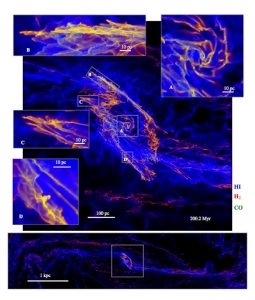
Idealised hydrodynamic simulations
With the development of more powerful supercomputers throughout the last few decades, numerical simulations provide a powerful, theoretical framework to understand the physics driving the formation and evolution of galaxies. Specifically, the evolution of the gaseous interstellar medium (ISM) in a galaxy can be described as a hydrodynamic fluid, and can thus, be well modelled by hydrodynamic simulations, which numerically solve the gas-dynamical equations. At GalSpec, we conduct hydrodynamic simulations of idealised galactic environments, such as isolated galaxies or the central regions in galaxies, by developing and employing the moving-mesh code Arepo.
The ISM in galaxies is shaped by the interplay of several physical processes, which interact with each other in complex and often non-linear ways, and operate on a large range of spatial and temporal scales. In hydrodynamic simulations, to date, it is still impossible to capture the entire complexity of nature: while cosmological hydrodynamic simulations adopt empirically motivated, “ad-hoc” sub-grid models to smooth over the small-scale complexity of different baryonic processes to capture galaxy evolution on cosmological scales, idealised hydrodynamic simulations are instead able to study the ISM at high spatial resolution, they refrain as much as possible from the usage of uncertain sub-grid models, and they try to mainly employ recipes at high physical fidelity.
Despite lacking the cosmological context, idealised simulations are a powerful tool to conduct numerical experiments to accurately understand specific physical processes and their mutual interaction and role in shaping the ISM. In this sense it is desirable to reduce the complexity of the system studied and isolate the specific processes which are at the centre of our investigation. Therefore many of the projects studied at GalSpec are accompanied by a large set of models which per-se are not designed to reproduce observations, but to give us valuable information on the physical processes at play.
